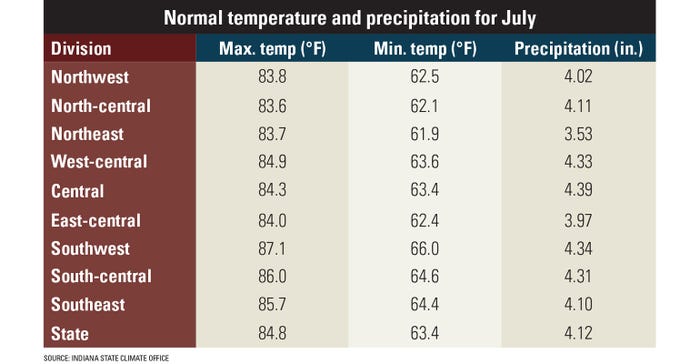
The maps issued by the National Oceanic and Atmospheric Administration’s Climate Prediction Center point toward some chance of warmer-than-normal temperatures in July. The same forecast maps indicate equal chances of above, below or normal rainfall during the same period.
What the forecasters actually say is that there is a 33% chance temperatures could be warmer than normal. It’s like a 33% chance of rain tomorrow. The scales are tipped that way, but it might not happen. That’s how Ken Scheeringa, associate state climatologist, explains how to interpret the maps.
Warmer than normal was projected in May, but the percentage wasn’t exceptionally high. No prediction could be made on rainfall in advance. As it turns out, May was cooler than normal in many areas and much wetter than normal in many places. The point is, these long-term forecasts are best guesses, but they don’t always turn out to be correct, especially the further out they’re made.
True confessions
The table below of average temperature and rainfall totals for July by crop reporting district and statewide indicates that the entire state averages nearly 4 inches or more of rain in July. This data is based on 30 years of weather records.
I have a confession to make. Many years ago I was grading record sheets for the 4-H weather project in a county that values the quality of record sheets. One question related to the wettest month of the year. One 4-H’er after another said “July,” and I marked it with an X time after time. Everybody knows July is hot and dry. Where were these kids getting this information?
It turns out they were getting it from their weather manual. I was so certain I was right that I didn’t bother to look it up. While parts of July are often hot and dry, overall a lot of rain typically falls in July in Indiana.
It also illustrates the point about trends. Even if the overall trend is normal, for example, and the state receives over 4 inches of rain in July, a week or more within that stretch can be bone-dry and hot. When everything is averaged out, it’s normal.
I apologize to all those kids who I thought were wrong years ago. One good thing came out of my mistake. I double-check my “facts” as much as possible now!

About the Author(s)
You May Also Like




